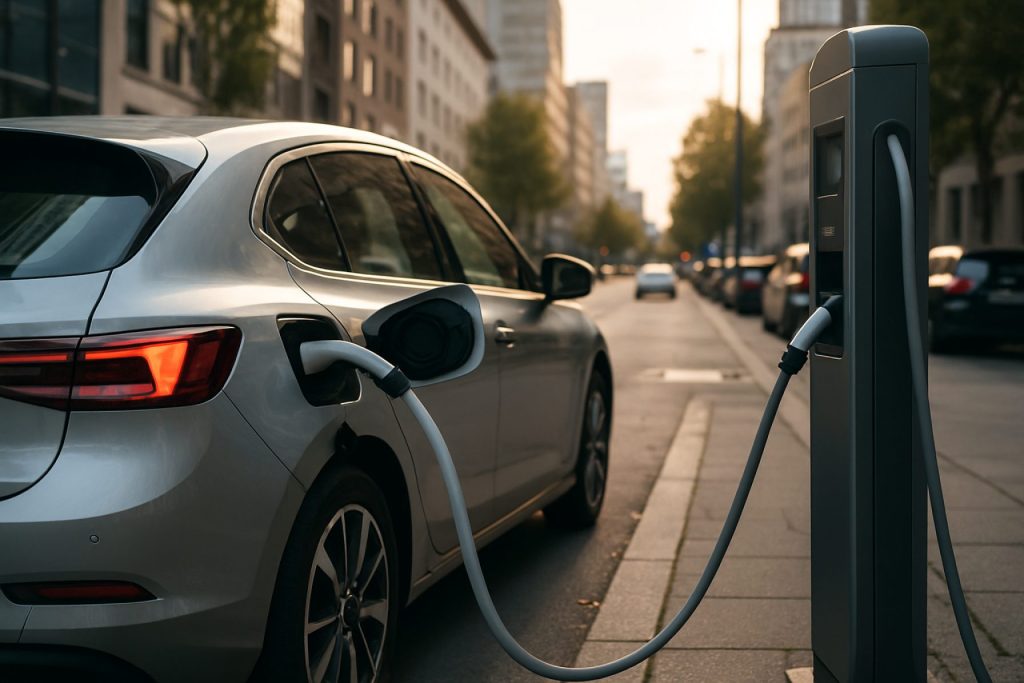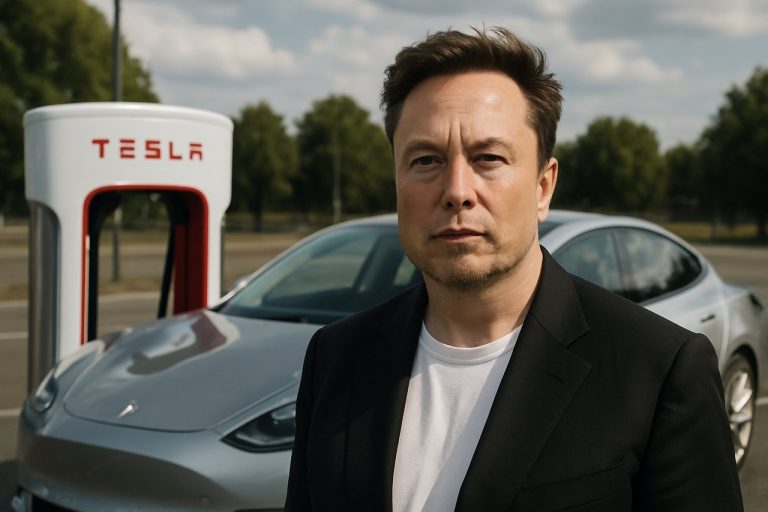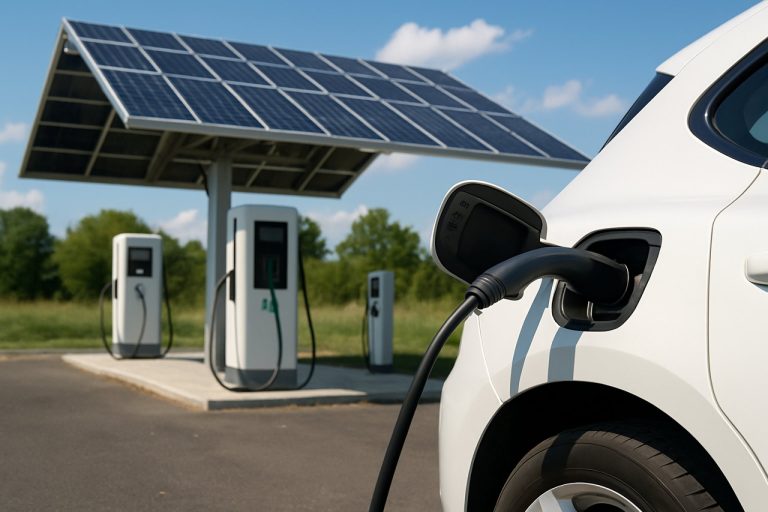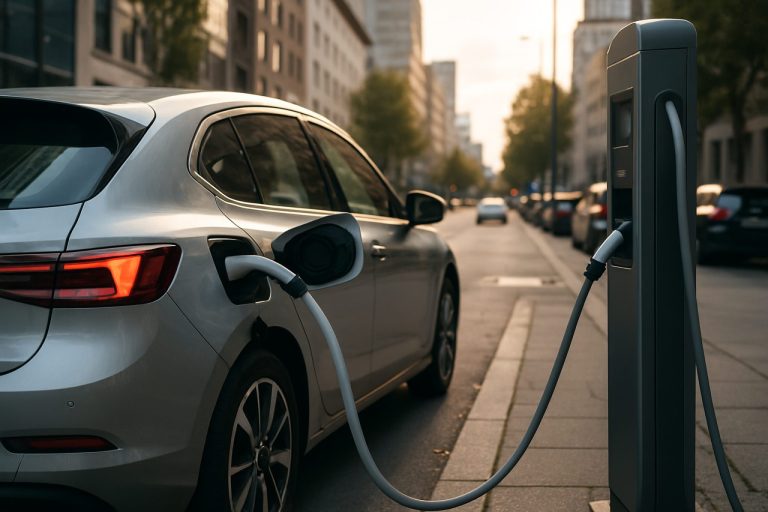
Urban Charging Infrastructure in 2025: How Cities Are Accelerating EV Adoption and Transforming Mobility. Explore the Technologies, Market Growth, and Strategic Shifts Shaping the Next Five Years.
- Executive Summary: Urban Charging in 2025 and Beyond
- Market Size and Growth Forecasts (2025–2030): CAGR and Key Drivers
- Policy, Regulation, and City Initiatives: Shaping Urban Charging Networks
- Technology Innovations: Fast Charging, Smart Grids, and Wireless Solutions
- Key Players and Strategic Partnerships: OEMs, Utilities, and Infrastructure Providers
- Deployment Models: Public, Private, and Mixed-Use Charging Hubs
- User Experience: Accessibility, Payment Systems, and Digital Integration
- Grid Impact and Energy Management: Integrating Renewables and Storage
- Challenges and Barriers: Urban Density, Permitting, and Equity
- Future Outlook: Urban Charging’s Role in Sustainable Urban Mobility
- Sources & References
Executive Summary: Urban Charging in 2025 and Beyond
Urban charging infrastructure is entering a pivotal phase in 2025, driven by accelerating electric vehicle (EV) adoption, ambitious municipal climate targets, and significant investments from both public and private sectors. As cities worldwide aim to decarbonize transport, the deployment and modernization of urban charging networks are becoming central to sustainable mobility strategies.
By 2025, the number of public charging points in major urban centers is expected to surpass several million globally, with leading cities in Europe, North America, and Asia setting benchmarks for density and accessibility. For example, Tesla, Inc. continues to expand its Supercharger and Destination Charger networks, focusing on high-traffic urban corridors and integrating fast-charging capabilities. Similarly, IONITY GmbH, a joint venture among major automakers, is scaling up its high-power charging stations across European cities, targeting both urban and intercity routes.
Municipalities are increasingly partnering with infrastructure specialists such as ChargePoint Holdings, Inc. and Blink Charging Co. to deploy curbside and public parking chargers, addressing the needs of residents without private parking. In 2025, these collaborations are expected to accelerate, with cities like London, Paris, and Los Angeles aiming for thousands of new public charging points annually. The integration of smart charging—enabling dynamic load management and grid balancing—is also becoming standard, as seen in pilot projects by Enel X and Siemens AG.
Urban charging infrastructure is also evolving to support a wider range of vehicle types, including electric buses, taxis, and commercial fleets. Companies such as EVBox Group and ABB Ltd. are introducing modular, high-capacity charging solutions tailored for fleet depots and transit hubs, reflecting the growing electrification of urban logistics and public transport.
Looking ahead, the outlook for urban charging infrastructure is shaped by ongoing policy support, technological innovation, and the imperative to ensure equitable access. Cities are expected to prioritize the deployment of chargers in underserved neighborhoods and to integrate renewable energy sources into charging networks. As the EV market matures, interoperability and user experience will be key differentiators, with industry leaders investing in seamless payment systems and real-time charger availability data.
In summary, 2025 marks a transformative year for urban charging infrastructure, with rapid expansion, smarter networks, and a focus on inclusivity setting the stage for the next phase of urban mobility electrification.
Market Size and Growth Forecasts (2025–2030): CAGR and Key Drivers
The urban charging infrastructure market is poised for robust growth between 2025 and 2030, driven by accelerating electric vehicle (EV) adoption, supportive government policies, and significant investments from both public and private sectors. As cities worldwide intensify efforts to decarbonize transportation, the demand for accessible, reliable, and high-speed charging solutions is surging.
By 2025, the global stock of public EV charging points is expected to surpass 5 million, with urban areas accounting for a substantial share due to higher population density and greater EV penetration. Key players such as Tesla, Inc., ABB Ltd., and BP p.l.c. (through its bp pulse division) are expanding their urban charging networks, focusing on both fast and ultra-fast charging stations to meet the needs of city dwellers and commercial fleets.
The compound annual growth rate (CAGR) for the urban charging infrastructure market is projected to range between 25% and 35% from 2025 to 2030, reflecting the rapid pace of deployment and technological innovation. This growth is underpinned by several key drivers:
- Government Incentives and Regulation: Urban authorities are mandating the installation of charging points in new residential and commercial developments, while national governments offer subsidies and tax incentives to accelerate infrastructure rollout. For example, the European Union’s Alternative Fuels Infrastructure Regulation (AFIR) requires member states to ensure a minimum number of public charging points in urban areas by 2025.
- Private Sector Investment: Major energy and automotive companies are investing heavily in urban charging networks. Shell plc is targeting the installation of over 500,000 charging points globally by 2025, with a significant focus on city locations. Similarly, Volkswagen AG is expanding its Elli charging network across European cities.
- Technological Advancements: The rollout of high-power DC fast chargers and smart charging solutions is enhancing user convenience and grid integration. Companies like ABB Ltd. are pioneering modular, scalable charging systems tailored for dense urban environments.
- Urban Mobility Trends: The rise of shared mobility services and electrified public transport fleets is increasing demand for strategically located charging hubs in city centers and transit corridors.
Looking ahead, the urban charging infrastructure market is expected to remain highly dynamic, with ongoing innovation in hardware, software, and business models. Strategic partnerships between utilities, automakers, and technology providers will be crucial in scaling up infrastructure to meet the evolving needs of urban EV users.
Policy, Regulation, and City Initiatives: Shaping Urban Charging Networks
Urban charging infrastructure is rapidly evolving as cities worldwide respond to the accelerating adoption of electric vehicles (EVs) and the need for sustainable urban mobility. In 2025, policy frameworks, regulatory mandates, and city-led initiatives are playing a pivotal role in shaping the deployment and accessibility of charging networks.
A significant trend is the integration of charging infrastructure requirements into urban planning and building codes. For example, several major cities in Europe and North America have enacted regulations mandating that new residential and commercial developments include a minimum number of EV charging points. In the United Kingdom, the government has required all new homes and buildings to have EV charge points installed from 2022 onwards, a policy that is now influencing urban landscapes and is expected to be mirrored in other regions by 2025 (UK Government).
Municipalities are also leveraging public-private partnerships to accelerate the rollout of charging stations. Companies such as IONITY—a joint venture between major automakers including BMW Group, Ford, Mercedes-Benz AG, and Volkswagen Group—are collaborating with city authorities to expand high-power charging corridors in urban centers across Europe. Similarly, Tesla, Inc. continues to expand its Supercharger network in metropolitan areas, often working with local governments to secure strategic locations and grid access.
In the United States, the federal government’s National Electric Vehicle Infrastructure (NEVI) Formula Program, launched in 2022, is providing billions in funding to states and cities to build out urban and corridor charging networks. This initiative is expected to result in thousands of new charging stations in urban areas by 2025, with a focus on equitable access and interoperability (U.S. Department of Transportation).
City-specific initiatives are also gaining momentum. For instance, the City of Los Angeles has committed to installing over 10,000 public chargers by 2025, prioritizing underserved neighborhoods and integrating charging with public transit hubs (City of Los Angeles). In China, urban centers such as Shanghai and Shenzhen are leading the world in public charging density, supported by national policies and partnerships with major suppliers like State Grid Corporation of China.
Looking ahead, the outlook for urban charging infrastructure is shaped by continued regulatory support, technological innovation (such as ultra-fast and bidirectional charging), and a growing emphasis on equitable access. As cities set ambitious electrification targets for public and private fleets, the interplay between policy, regulation, and proactive city initiatives will remain central to the expansion and modernization of urban charging networks.
Technology Innovations: Fast Charging, Smart Grids, and Wireless Solutions
Urban charging infrastructure is undergoing rapid transformation in 2025, driven by the convergence of fast charging, smart grid integration, and emerging wireless solutions. As electric vehicle (EV) adoption accelerates in metropolitan areas, cities are prioritizing the deployment of high-capacity charging networks to address both range anxiety and grid stability concerns.
A key trend is the expansion of ultra-fast charging stations, with leading manufacturers such as ABB and Siemens rolling out 150 kW to 350 kW DC chargers across major urban corridors. These high-power units can replenish most EV batteries to 80% in under 20 minutes, significantly reducing dwell times and supporting the needs of ride-hailing fleets, taxis, and urban delivery vehicles. ABB has announced partnerships with city authorities to integrate their Terra HP chargers into public transit hubs and parking facilities, while Siemens is piloting modular charging parks that can scale with local demand.
Smart grid integration is another cornerstone of urban charging innovation. Utilities and technology providers are collaborating to deploy intelligent charging management systems that balance EV load with real-time grid conditions. Enel, through its subsidiary Enel X, is working with municipalities to implement demand response programs and vehicle-to-grid (V2G) pilots, enabling EVs to act as distributed energy resources. These systems help mitigate peak demand, reduce infrastructure strain, and support the integration of renewable energy sources into the urban grid.
Wireless charging is also gaining traction in select urban environments. Companies like WiTricity are advancing inductive charging pads for both public and private use, targeting high-traffic locations such as taxi ranks and bus stops. In 2025, several cities are trialing dynamic wireless charging embedded in roadways, allowing vehicles to recharge while in motion—an innovation that could further reduce the need for stationary charging stops and optimize urban mobility.
Looking ahead, the outlook for urban charging infrastructure is shaped by continued investment from both public and private sectors. City governments are leveraging funding and regulatory incentives to accelerate the buildout of accessible, high-speed charging networks. Meanwhile, industry leaders are focusing on interoperability, open standards, and user-centric design to ensure seamless charging experiences. As these technologies mature, urban centers are poised to become models of efficient, resilient, and sustainable EV charging ecosystems.
Key Players and Strategic Partnerships: OEMs, Utilities, and Infrastructure Providers
The rapid expansion of urban charging infrastructure is being shaped by a dynamic ecosystem of key players, including original equipment manufacturers (OEMs), utilities, and specialized infrastructure providers. As electric vehicle (EV) adoption accelerates in 2025, strategic partnerships among these stakeholders are critical to overcoming challenges related to grid integration, site acquisition, and user experience.
OEMs are increasingly moving beyond vehicle production to play a direct role in charging infrastructure. Tesla, Inc. continues to expand its Supercharger network, now opening access to non-Tesla EVs in select urban markets, a move that both increases utilization and supports broader EV adoption. Similarly, Volkswagen AG—through its subsidiary Electrify America—has established a significant urban presence, focusing on high-speed charging corridors and city hubs. BMW Group and Mercedes-Benz Group AG have also announced joint ventures to deploy premium charging stations in metropolitan areas, aiming to enhance convenience and brand loyalty.
Utilities are pivotal in enabling large-scale urban charging, leveraging their expertise in grid management and infrastructure investment. Électricité de France (EDF) and Enel S.p.A. are notable for their urban charging initiatives, integrating smart grid technologies and renewable energy sources to support sustainable growth. In the United States, Southern California Edison and Consolidated Edison Company of New York, Inc. are actively collaborating with municipalities and private partners to deploy public charging stations and manage load impacts in dense urban environments.
Dedicated infrastructure providers are scaling rapidly through both organic growth and strategic alliances. ChargePoint Holdings, Inc. and EVgo, Inc. are expanding their urban footprints, often partnering with retail, hospitality, and real estate companies to secure high-traffic locations. IONITY GmbH, a joint venture of major European OEMs, is extending its high-power charging network into city centers, while BP p.l.c. and Shell plc are converting urban fuel stations into multi-modal energy hubs with fast-charging capabilities.
Looking ahead, the next few years will see intensified collaboration among these players, with joint ventures and public-private partnerships expected to accelerate deployment. The integration of digital payment systems, real-time data sharing, and grid-responsive charging will be central to meeting the needs of urban EV drivers and supporting the broader transition to sustainable mobility.
Deployment Models: Public, Private, and Mixed-Use Charging Hubs
Urban charging infrastructure is rapidly evolving to meet the surging demand for electric vehicle (EV) adoption in cities. As of 2025, deployment models are diversifying, with public, private, and mixed-use charging hubs each playing distinct roles in supporting urban mobility and sustainability goals.
Public charging hubs are typically installed and operated by municipal authorities or in partnership with major energy and utility companies. These hubs are strategically located in high-traffic urban areas, such as parking garages, transit centers, and commercial districts, to maximize accessibility. For example, Shell has expanded its public charging network in major cities, converting traditional fuel stations into EV charging points and collaborating with city governments to deploy fast-charging infrastructure. Similarly, ENGIE and EDF are actively involved in large-scale urban charging projects across Europe, focusing on interoperability and integration with public transport systems.
Private charging hubs are primarily developed by property owners, commercial real estate firms, and fleet operators. These installations are often found in office complexes, residential buildings, and logistics centers, catering to specific user groups such as employees, tenants, or delivery fleets. Companies like Tesla have continued to expand their proprietary Supercharger network, including urban locations, while Volkswagen Group (through its subsidiary Elli) is investing in private charging solutions for corporate and residential customers. These private networks often offer higher charging speeds and tailored services, such as reservation systems and integrated billing.
Mixed-use charging hubs are emerging as a flexible solution to maximize infrastructure utilization and support diverse user needs. These hubs combine public access with dedicated private charging for fleets or building occupants. For instance, BP (through its BP Pulse division) is piloting mixed-use charging sites in urban centers, offering both rapid public charging and reserved bays for ride-hailing or delivery vehicles. IONITY, a joint venture among major automakers, is also exploring mixed-use models to serve both private EV owners and commercial operators.
Looking ahead, the outlook for urban charging infrastructure deployment is shaped by increasing collaboration between city authorities, utilities, and private sector players. Regulatory incentives, grid integration, and digital platforms for real-time availability and payment are expected to accelerate the rollout of all three deployment models. As cities aim for zero-emission transport targets, the interplay between public, private, and mixed-use charging hubs will be critical to ensuring equitable, reliable, and scalable access to EV charging in urban environments.
User Experience: Accessibility, Payment Systems, and Digital Integration
Urban charging infrastructure in 2025 is rapidly evolving to address the needs of a growing electric vehicle (EV) user base, with a strong focus on user experience, accessibility, payment systems, and digital integration. As cities worldwide accelerate EV adoption, the quality and inclusivity of charging networks are becoming as important as their scale.
Accessibility remains a central concern. Leading charge point operators such as IONITY GmbH and EVgo, Inc. are expanding urban networks with a focus on high-traffic locations, including shopping centers, public parking, and transit hubs. In 2025, new installations increasingly comply with universal design standards, offering features like barrier-free access, clear signage, and support for users with disabilities. For example, Tesla, Inc. has begun retrofitting select Supercharger sites to improve accessibility, including wider bays and tactile paving.
Payment systems are undergoing significant transformation. The industry is moving away from proprietary cards and closed networks toward open, interoperable solutions. In Europe, the CharIN e.V. association is driving the adoption of the ISO 15118 standard, enabling Plug & Charge functionality—where authentication and billing occur automatically when the vehicle connects to the charger. Major networks like ChargePoint Holdings, Inc. and Enel X are rolling out contactless payment options, including credit/debit cards and mobile wallets, to reduce friction for occasional and cross-network users.
Digital integration is a defining trend in 2025. Most urban charging stations now support real-time data sharing with navigation apps and vehicle infotainment systems, allowing users to locate available chargers, check power levels, and reserve slots. BP p.l.c. (through its bp pulse network) and Shell plc (via Shell Recharge) are investing in cloud-based platforms that integrate charging, payment, and loyalty programs. These platforms often leverage APIs to connect with third-party mobility services, supporting seamless multimodal journeys.
Looking ahead, the next few years will likely see further harmonization of standards and increased collaboration between automakers, utilities, and tech providers. The push for equitable access—ensuring that charging is available in underserved urban neighborhoods—remains a policy priority in many regions. As digital ecosystems mature, the urban charging experience is expected to become more intuitive, inclusive, and integrated into daily urban mobility.
Grid Impact and Energy Management: Integrating Renewables and Storage
The rapid expansion of urban charging infrastructure is reshaping the energy landscape in cities worldwide, with significant implications for grid impact and energy management. As electric vehicle (EV) adoption accelerates, urban centers are experiencing a surge in demand for reliable, high-capacity charging solutions. In 2025, major cities are prioritizing the integration of renewables and energy storage to mitigate grid stress and enhance sustainability.
Leading charging network operators such as Tesla, Inc. and IONITY GmbH are deploying ultra-fast charging stations in dense urban areas, often co-located with solar photovoltaic (PV) arrays and battery energy storage systems (BESS). These integrated solutions help balance peak loads, reduce reliance on fossil-fuel-based grid electricity, and support local grid stability. For example, Tesla, Inc. has expanded its Supercharger network in metropolitan regions, increasingly pairing stations with on-site Powerpack or Megapack storage to buffer demand spikes and enable renewable energy utilization.
Utilities and grid operators are also adapting to the evolving urban charging landscape. Enel S.p.A., through its subsidiary Enel X, is collaborating with municipalities to deploy smart charging infrastructure that dynamically adjusts charging rates based on grid conditions and renewable generation availability. This approach leverages advanced demand response algorithms and real-time data analytics to optimize energy flows, minimizing grid congestion and curtailment of renewables.
In 2025, regulatory frameworks in regions such as the European Union and select U.S. states are mandating that new public charging installations incorporate renewable energy sourcing and storage capabilities. This is driving innovation among hardware suppliers like Siemens AG and ABB Ltd., who are introducing modular charging platforms with integrated solar and battery options tailored for urban deployment. These systems are designed to support vehicle-to-grid (V2G) functionality, enabling bidirectional energy flows that further enhance grid flexibility and resilience.
Looking ahead, the outlook for urban charging infrastructure is characterized by increasing convergence between mobility, energy, and digital technologies. The proliferation of distributed energy resources (DERs), coupled with advanced energy management systems, is expected to transform urban charging hubs into active grid participants. By 2027, industry leaders anticipate that a significant share of urban charging stations will operate as microgrids, capable of autonomously managing local energy generation, storage, and consumption while providing ancillary services to the broader grid.
Challenges and Barriers: Urban Density, Permitting, and Equity
Urban charging infrastructure faces a unique set of challenges and barriers in 2025, particularly in dense city environments. As electric vehicle (EV) adoption accelerates, cities must address issues related to space constraints, complex permitting processes, and equitable access to charging for all residents.
Urban density presents a fundamental obstacle. In cities where real estate is at a premium and street parking dominates, installing public charging stations is logistically difficult. Many residents lack private driveways or garages, making home charging infeasible. According to Tesla, Inc., which operates one of the world’s largest fast-charging networks, urban Supercharger installations require creative solutions such as integrating chargers into existing parking structures or collaborating with retail and municipal partners. Similarly, Volkswagen AG and its subsidiary Electrify America are piloting curbside and community charging hubs in major U.S. cities to address these spatial limitations.
Permitting and regulatory hurdles further slow deployment. Urban charging projects often require coordination with multiple city agencies, utilities, and property owners. The process can be lengthy, with requirements for electrical upgrades, zoning variances, and public consultations. ChargePoint Holdings, Inc., a leading charging network operator, has highlighted the need for streamlined permitting and standardized regulations to accelerate infrastructure rollout. Some cities, such as Los Angeles and London, are experimenting with “fast-track” permitting programs to reduce installation times from months to weeks.
Equity remains a critical concern. Without deliberate planning, charging infrastructure risks reinforcing existing disparities. Lower-income neighborhoods and communities of color are often underserved by both public and private charging investments. EVgo, Inc., another major U.S. charging provider, has committed to expanding access in disadvantaged urban areas through partnerships with local governments and targeted funding. The U.S. Department of Energy and similar agencies in Europe are offering grants and incentives to ensure that charging stations are distributed equitably, including in multi-unit dwellings and public housing.
Looking ahead, the outlook for urban charging infrastructure is cautiously optimistic. Advances in compact charger design, wireless charging, and integration with public transit hubs are expected to ease some spatial and logistical barriers. However, sustained progress will depend on continued public-private collaboration, regulatory innovation, and a focus on equitable access to ensure that the benefits of electrification reach all urban residents.
Future Outlook: Urban Charging’s Role in Sustainable Urban Mobility
Urban charging infrastructure is rapidly evolving as a cornerstone of sustainable urban mobility, particularly as cities worldwide accelerate their transition to electric vehicles (EVs). By 2025, the deployment of public and semi-public charging stations is expected to intensify, driven by ambitious electrification targets and regulatory frameworks in major urban centers. For example, the European Union’s Alternative Fuels Infrastructure Regulation (AFIR) mandates that member states significantly expand charging networks, aiming for at least one charging point every 60 kilometers along major roads and substantial urban coverage by 2025. This regulatory push is mirrored in North America and Asia, where cities like New York, Los Angeles, Shanghai, and Berlin are investing heavily in public charging accessibility.
Key industry players are scaling up their urban charging solutions. Tesla, Inc. continues to expand its Supercharger and Destination Charger networks, with a growing focus on urban locations and high-density residential areas. ChargePoint Holdings, Inc., one of the world’s largest EV charging networks, is partnering with municipalities and property owners to deploy Level 2 and DC fast chargers in city centers, parking garages, and retail hubs. BP p.l.c. (through BP Pulse) and Shell plc are also investing in urban charging, integrating fast-charging stations at forecourts and urban retail sites, and piloting innovative solutions such as charging hubs and on-street chargers.
Data from International Energy Agency indicates that by 2025, the global stock of public charging points could surpass 4 million, with urban areas accounting for the majority of new installations. The focus is shifting toward high-power DC fast charging to reduce dwell times and support the growing fleet of electric taxis, ride-hailing vehicles, and urban delivery vans. Additionally, interoperability and user experience are being prioritized, with companies like ABB Ltd and Siemens AG developing open standards and integrated payment systems to streamline access across networks.
Looking ahead, urban charging infrastructure will play a pivotal role in enabling low-emission zones, supporting shared mobility, and integrating with renewable energy sources. The next few years will likely see increased deployment of smart charging solutions, vehicle-to-grid (V2G) capabilities, and the integration of charging infrastructure with public transport nodes. As cities pursue climate goals and electrification accelerates, robust, accessible, and scalable urban charging networks will be essential to the future of sustainable urban mobility.
Sources & References
- IONITY GmbH
- ChargePoint Holdings, Inc.
- Blink Charging Co.
- Enel X
- Siemens AG
- EVBox Group
- BP p.l.c.
- Shell plc
- Volkswagen AG
- UK Government
- City of Los Angeles
- Enel
- WiTricity
- Southern California Edison
- Consolidated Edison Company of New York, Inc.
- EVgo, Inc.
- Volkswagen Group
- Elli
- CharIN e.V.
- Electrify America
- International Energy Agency



